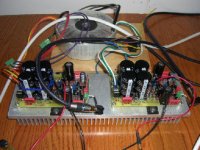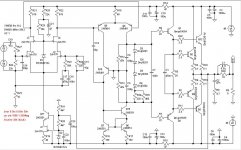costiss said:this is a similar to the symasym design, that puts out >200w@8R..
Yes, that's a nice kit. What makes you think it gives >200w into 8 ohm ? It's more like 120...150w.
Mike
i am sorry.. 🙁
i am now building the hx200 from amplab, that has a 2xirfp240/2xirfp9240 output stage, with similar circuit, that does make out 206w@8ohm nd 363w@4Ohm (as from what i ve measured), with +/- 72v rails.. you are right.. this one makes about 110-120..
to avoid any misunderstandings, ampslab states 330w@4R from hx200, but with a 450va/2x22mf psu. i use a 1kva/2x100mf one..😀
really, is there any case we could group buy the pcbs for this symasym version? this would be nice.. good double layer pcb manufacture for few pieces is actually non existant here..
i am now building the hx200 from amplab, that has a 2xirfp240/2xirfp9240 output stage, with similar circuit, that does make out 206w@8ohm nd 363w@4Ohm (as from what i ve measured), with +/- 72v rails.. you are right.. this one makes about 110-120..
to avoid any misunderstandings, ampslab states 330w@4R from hx200, but with a 450va/2x22mf psu. i use a 1kva/2x100mf one..😀
really, is there any case we could group buy the pcbs for this symasym version? this would be nice.. good double layer pcb manufacture for few pieces is actually non existant here..

Interesting Roender. I have a 30-0-30 300VA traffo that's looking for a home. Will you be doing a PCB layout, or should I give it a go?
I will build it first on perforated board and I will make gerber/exelon files in Eagle after some tests.
What do you think about input and output stages?
I my humble opinion, VAS is the strongest point of symasym and must not be afected by changes because it will lose dominant 2nd harmonics
What do you think about input and output stages?
I my humble opinion, VAS is the strongest point of symasym and must not be afected by changes because it will lose dominant 2nd harmonics
Hi Roender, nice job! 🙂
3 comments:
1, why jfets as cascodes in 1st stage ?
2, "High" power ? 😀
3, I think, you should use a more sophisticated ccs instead of r29. The current delivered here will be subtracted from the css to the diffamp. Both ccs should have the same psrr/quality.
Try it, it should work explendid... 😉
Did you try the cascoded vas ?
Mike
3 comments:
1, why jfets as cascodes in 1st stage ?
2, "High" power ? 😀
3, I think, you should use a more sophisticated ccs instead of r29. The current delivered here will be subtracted from the css to the diffamp. Both ccs should have the same psrr/quality.
Try it, it should work explendid... 😉
Did you try the cascoded vas ?
Mike
MikeB said:Hi Roender, nice job! 🙂
Try it, it should work explendid... 😉
Mike
Thank you Mike
I will try to answer your questions and I will begin with no 3.
The requested current to mentain Vz stable is very small and is not influenced by change in load of diff amp (Ig is many orders small compared with Ib of BJTs). This is one point ahead in favor of JFETs instead BJTs as cascode devices.
The second advantage of these devices as cascodes, is capacitance (strange but true). We will have two capacitance in series, cascoded and cascode, and the resulting capacitance will be reduced by two. The best way to cascode JFETs is to use another JFET or MOSFET.
Well, the power is not to high 😀 but sufficient to drive, for sort periods of time, 2ohm loads. I don't need to much power because I have speakers with 92dB SPL (1W@1m)
And at last, yes i had it with cascoded VAS. Is not worth effort and parts, the symasym will lose all good sound. The 2nd harmonic is a good one.
Have a nice night,
Mihai
roender said:Symasym - HighPower
pinkmouse said:Will you be doing a PCB layout, or should I give it a go?
Wow! Higher power? Pink boards? MikeB's Symasym?
 Could it get any better?
Could it get any better? Shawn.
Hi Mihai,
I believe in using the proper tool for the job. You can use a hammer for just about anything, but a screwdriver helps too!
-Chris
I believe in using the proper tool for the job. You can use a hammer for just about anything, but a screwdriver helps too!
-Chris
Hi Chris
You are right, screwdriver helps sometimes 😀. Please read carfully all the reasons i had in using JFETs as cascode device.
http://www.diyaudio.com/forums/showthread.php?postid=1101463#post1101463
Mihai
You are right, screwdriver helps sometimes 😀. Please read carfully all the reasons i had in using JFETs as cascode device.
http://www.diyaudio.com/forums/showthread.php?postid=1101463#post1101463
Mihai
- Status
- Not open for further replies.
- Home
- Amplifiers
- Solid State
- Symasym - the sequel




